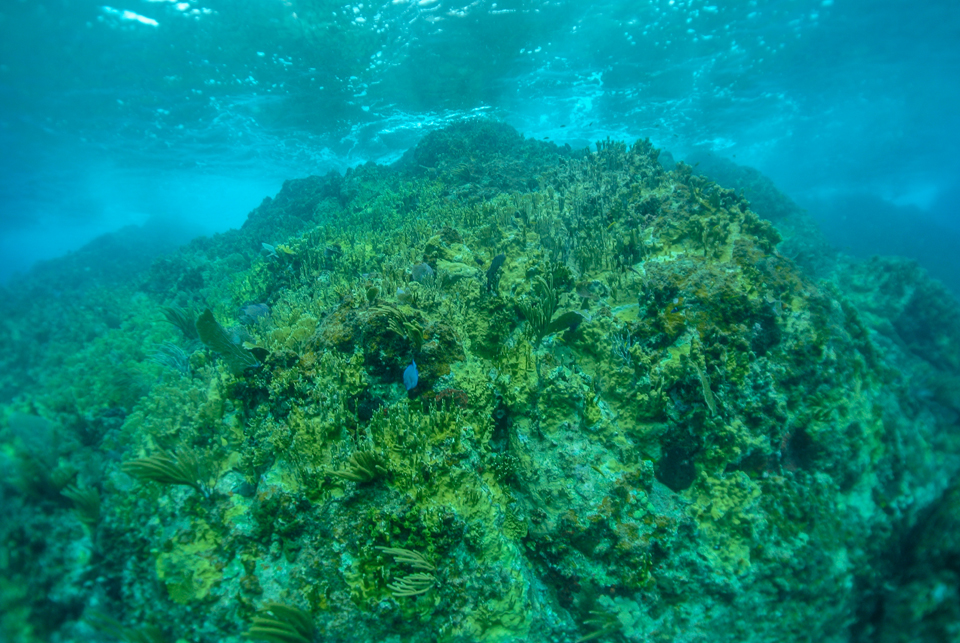Surviving Coral Alone Cannot Keep Reefs Alive, CSUN Prof’s Research Shows

CSUN marine biologist Peter Edmunds said three decades research chronicling the life history of the coral reefs off the Caribbean island of St. John in the U.S. Virgin Islands indicates surviving coral alone cannot keep reefs alive, which has implications for coral reefs around the world. Photo courtesy of Peter Edmunds.
By carefully chronicling life on the coral reefs off the Caribbean island of St. John in the U.S. Virgin Islands every year for the past 30 years, California State University, Northridge marine biologist Peter Edmunds has been able to track which corals have survived the ravages of hurricanes and the impact of climate changes, and which have not, and gain insight into the future of the reef.
What Edmunds has found that those populations of coral that have survived cannot produce as much carbonate rock as those that have died off. Coral calcification is the rate at which reef-building corals lay down their calcium carbonate skeleton. It is a measure of coral growth, which is important for healthy reef systems, and to build the wave-resistant platforms protecting shores and providing homes to countless animals and algae.
“While the corals remaining are keeping the reef alive, we just don’t know how long these really weedy coral can keep it up,” Edmunds said.
The results of his research, “Decadal-scale variation in coral calcification on coral-depleted Caribbean reefs,” were published today in the journal Marine Ecology Progress Series. His co-author is Chris Perry, a professor of tropical coastal geoscience at the University of Exeter in the United Kingdom.
Edmunds, who teaches in CSUN’s College of Science and Mathematics, said the data he has collected over the past three decades off St. John provide information about what is happening in the marine communities supported by coral reefs — not just off St. John, but around the world — as well as an indication of how well those communities will survive the continuing impact of climate change.
“The demographic information has allowed me to talk about how big the coral population is, how quickly it’s growing, how rapidly it’s shrinking and when it might disappear,” Edmunds said. “Now that I have that information, I am able to ask related questions about what goods and services the population is able to deliver to the ecosystem.
“To put this in more accessible terms, we can look at the coral as a delivery service,” he said. “What we’re interested in here is what sort of service, ecologically and geologically, the coral have the ability to deliver. In this case, it’s rock (in the form of coral calcification). Rock is the foundation of the reef. It builds the habitat. It builds the wave-resistant platform on which the fishes, sea urchins and so on rely. Since we have this exquisite level of detail of how many coral colonies there are, how big they are, who they are, and how these features have changed over time, we can now calculate how much rock each one creates, add it up and come up with an amount that has been deposited every year since 1992.”
Edmunds said that the COVID-19 pandemic lockdown gave him and his team the time to closely reexamine the decades of data from St. John. While his research showed fire coral were continuing to survive on the shallow reefs, the calcium carbonate skeletons the coral leave behind are not enough to rebuild portions of the reef’s basic foundation that already have been lost.
“An analogy is that the reefs of the 1980s produced a beautiful brick house surrounded by a beautiful garden,” Edmunds said. “Over the past 30 or 40 years, the beautiful brick home has fallen into a sad state of disrepair. The house itself has fallen down, and people had stolen bricks to the point that you can barely recognize that a house was ever there. However, there still is a little brick wall around the garden that marks the property’s margin. The fire corals and weedy corals on the reef are building that brick wall.
“What we’re finding is that is seems that the brick wall, in its depleted state, has become quite stable,” he said. “That brick wall is the limestone the small remaining population of corals are now delivering. The whole house is kind of gone, but the coral are still able to maintain that ‘little wall around the garden’ and keep it stable.
“We were very surprised to find that the little wall around the garden is still there,” he continued. “It seems that this diminutive coral population is not producing very much rock at all, but what it is producing has persisted for decades. While it’s not the best news in the world for corals reefs, it does support cautious optimism. The ‘wall’ is not on track to disappear, based on the data we have collected for nearly 30 years. We’re not going to be able to rebuild that beautiful home, unless we do something profoundly different. But the small amount of coral that remain are doing an okay job of maintaining the wall, at least for now.”

 experience
experience